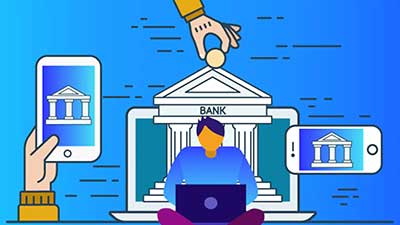Date: 02/01/2023
Relevance: GS-3: Indian Economy and issues relating to planning, mobilization, of resources, growth, development and employment.
Key Phrases: Full-Stack Digital Banks, The Next Stage Of Financial Inclusion, The Next Stage Of Financial Inclusion, Public Credit Registry, Digitalization Of Loan Documents
Context:
- NITI Aayog published a discussion paper titled “Digital Banks: A Proposal for Licensing & Regulatory Regime for India”, which explains the value proposition of full-stack digital banks.
- The reason behind the advocacy of full-stack digital banks is the lack of credit penetration among MSMEs and the full-stack digital banks are a potential solution for the persistent policy challenge of credit deepening and are seen as “the next stage of financial inclusion”.
Key Highlights:
- According to the ‘Expert Committee on Micro, Small and Medium Enterprises’ report submitted to RBI in 2019, there were 63.38 million MSMEs in India contributing about 45 percent to the manufacturing output, constituting 28 percent of the GDP and creating 111 million jobs.
- The report mentions that “due to their informal nature, MSMEs lack access to formal credit as banks face challenges in credit risk assessment owing to lack of financial information, historical cash flow data, etc.
- Further, very few MSMEs are able to attract equity support and venture capital financing.
Distinction between digital banks and Digital Banking Units:
- Digital banks are financial institutions that have no physical branches and offer banking services entirely online through their website and mobile banking app.
- Digital banks will be completely independent banks to be licensed under the Banking Regulation Act, 1949, and they will follow the Reserve Bank norms on par with commercial banks.
- DBUs do not have legal personality and are not separately licensed under the Act.
Compelling Factors To Make Digital Banks A Reality:
- According to a Deloitte study published in February, India will have one billion smartphone users by 2026 with rural areas driving the demand.
- Internet enabled devices in the rural market will also get a push with the government’s BharatNet programme.
- An estimated 205 million Indian adults already have a digital-only bank account, and this number is predicted to increase to 397 million within the next five years.
Online Banking Gaining Momentum With Evolving Infrastructure:
- Access to financial services at a lesser cost:
- The India Stack, consisting of identity rails (Aadhaar, e-KYC, e-Sign and Digilocker), payment rails (IMPS, UPI, RuPay, JanDhan, AEPS and APBS) and data sharing rails (Account Aggregators) is widening access to financial services at a lesser cost.
- Removal of documents from negative e-Sign list:
- The Ministry of Electronics and IT (MeitY) recently amended the Information Technology Act, 2000 removing several documents from the negative e-Sign list including key real estate and property agreements.
- Resultantly, negotiable instruments governed by financial regulators and Power of Attorney documents for businesses regulated by them can now be enforced electronically.
- Dematerialisation of home loans is now only a few steps away bringing transparency to these loans.
- Digitalization of loan documents:
- The government-backed National E-Governance Services Ltd. (NeSL), through its digital document execution (DDE) platform, has started digitalizing loan documents from submission to payment of stamp duty, to digital e-stamping to e-sign by the signatories to a completely secure digital storage system.
- NeSL has processed one million transactions through its DDE platform.
- Public Credit Registry (PCR):
- RBI is setting up a Public Credit Registry (PCR) which could reshape the credit ecosystem for the future so that microcredit can thrive to unlock economic value.
- PCR will help reduce information asymmetry by enabling the lender to know the credit history of past lenders and the current indebtedness of the borrower.
Issues with Traditional Banks:
- Traditional banks find it difficult to assess creditworthiness of SMEs while manually curating information from physical documents such as financial statements, tax returns and payroll statements.
- The current delivery systems are largely paper-based, with high turnaround time and requiring multiple visits to bank branches.
- It entails high operational costs for lenders and opportunity costs for borrowers.
- MSME borrowers want a fast approval process and certainty regarding funds availability.
- They value speed and convenience and want a seamless, consistent lending experience that delivers instant decisions and immediate delivery of funds.
Way Forward:
- Digital banks are best suited to usage of new age techniques like predictive analyses and artificial intelligence (AI) to arrive at real time decisions for time-busy MSMEs.
- These technologies allow banks to move from traditional funding methods based on collaterals to advanced cash flow lending.
- Digital banks can rethink and retool lending mechanism, credit underwriting process and gradually shun security-oriented lending.
- All that which has been done to payments ecosystem in India needs to be replicated in the field of credit assessment and delivery.
Conclusion:
- The infrastructure for digitising services allied to financial services already exists. What remains now is to connect these dots with digital banks to make full-stack digital banking services available to customers.
- Continuous innovation and new capabilities that digital banks are slated to bring will no doubt add more engines of growth to the financial sector.
Source: Hindu BL
Mains Question:
Q. The infrastructure for digitising services allied to financial services already exists. What remains now is to connect these dots with digital banks to make full-stack digital banking services available to customers. Comment. (150 words).






















